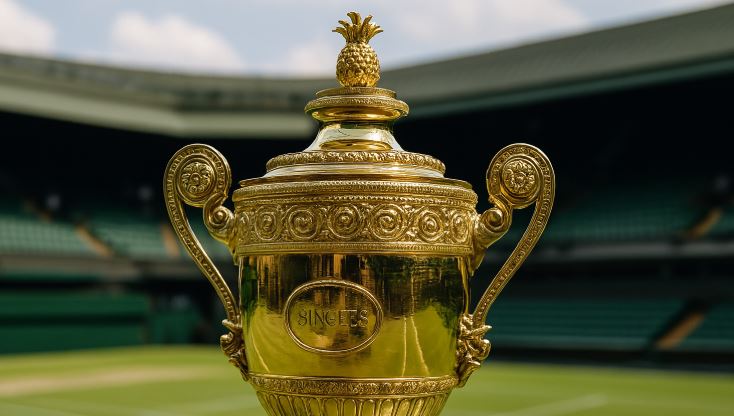Why Is There a Pineapple on the Wimbledon Trophy? | A Slice of Tennis History
Wimbledon is more than just tennis; it’s a legacy wrapped in tradition, elegance, and symbolism. Among the most curious features of this world-renowned championship is the pineapple perched atop the prestigious Gentlemen’s Singles Trophy.
It’s a question that’s puzzled fans and historians alike: why is there a pineapple on the Wimbledon trophy?
As I dug deeper into this charming mystery, I uncovered a tale that blends history, status, and the evolving traditions of sport.
What’s the Story Behind the Pineapple on the Wimbledon Trophy?

The Gentlemen’s Singles Trophy, awarded since 1887, is one of the most iconic symbols in tennis.
Made of silver gilt and standing at 18 inches tall, the trophy features an elegant inscription: “The All England Lawn Tennis Club Single Handed Championship of the World.” But it’s the ornamental pineapple perched on top that sparks curiosity year after year.
Despite the prestige of the trophy and the formality of the event, there’s no official explanation documented by the All England Club for the pineapple.
Yet, the most widely accepted theory ties back to symbolism from the 19th century, when Wimbledon was first established.
At the time, pineapples were highly sought-after and widely regarded as a luxurious delicacy. Their presence in artwork, architecture, and table settings was a declaration of wealth and hospitality.
The trophy’s pineapple may have been chosen not for its connection to tennis, but for its emblematic power.
In a sport that was historically reserved for the upper classes, the pineapple would have been a fitting nod to exclusivity and refinement.
How Did Pineapples Represent Status in Victorian Britain?
In the Victorian era, fruit wasn’t just food, it was a statement. Among all fruits, the pineapple reigned supreme as the ultimate luxury.
Importing pineapples was expensive and cultivating them in Britain required dedicated glasshouses and heated structures known as “pineries.”
Only the wealthiest households could afford to serve pineapples at events. In fact, some families would even rent a pineapple to display at dinner parties simply for show. The fruit became a symbol of:
- Social standing and opulence
- Hospitality and warmth
- Exoticism and global reach, especially tied to colonial exploration
Its image appeared frequently in architectural motifs, from gateposts to dining room cornices. Even in decorative arts, pineapples stood in as icons of sophistication.
Within this cultural context, it’s easier to understand why the pineapple might have been selected to top Wimbledon’s premier trophy, a perfect symbol for an elite sporting event in Victorian England.
When Was the First Wimbledon Trophy Introduced?

The tradition of awarding a trophy at Wimbledon began in 1877 with The Field Cup, named after the sporting newspaper that donated it.
That first tournament was won by Spencer Gore, but it wasn’t until William Renshaw’s dominance from 1881 to 1883 that the Field Cup became his property. Back then, any player who won three championships in a row earned the right to keep the trophy permanently.
With Renshaw’s continued success, the Challenge Cup was introduced in 1884. Renshaw once again rose to the top and retained this second trophy by 1886.
As a result, the All England Club decided to break the cycle and introduced a new trophy in 1887, declaring that it could never be claimed outright by any player, regardless of victories.
This decision marked a turning point in Wimbledon’s efforts to create a lasting legacy. The current Gentlemen’s Singles Trophy has since been awarded every year (with exceptions during the World Wars), making it one of the longest-standing trophies in sport.
How Much Does a Wimbledon Trophy Cost?

The Wimbledon Gentlemen’s Singles Trophy is not only rich in symbolism and tradition, it also came with a rather notable price tag when it was first commissioned.
Back in 1887, the All England Club spent 100 guineas on the trophy, a considerable amount at the time. To put that into context, one guinea was worth just over one British pound, making the total cost roughly £105 in Victorian currency.
While that might sound modest by today’s standards, it was a significant investment in the late 19th century. In today’s money, the value would translate to approximately £13,000 or more, depending on inflation and historical valuation methods.
This cost reflects both the craftsmanship of the piece and the importance the club placed on creating a lasting symbol of excellence.
The trophy itself is made from silver gilt, which means it’s crafted from silver and coated with a thin layer of gold to give it that iconic warm sheen.
It stands 18 inches (46 cm) tall and has a diameter of 7.5 inches (19 cm), giving it an elegant yet substantial presence.
The delicate detailing, from the ornate handles to the engraved inscription and the golden pineapple finial, suggests that this was no ordinary cup, it was designed to last through generations and become a centrepiece of the sport.
Why Did the All England Club Choose a Pineapple Design?

While there is no written record of the design process or artist behind the trophy, several historical clues provide insight.
During the late 1800s, it was common for ornamental items, including cups, urns, and architectural elements, to feature fruit motifs. Among these, the pineapple held a special cultural resonance.
Potential reasons for the pineapple’s selection include:
- Symbolic representation of victory and status
- Decorative trend in Victorian silverware
- Alignment with the elite image of Wimbledon during its early years
Additionally, fruit-bearing finials were popular adornments for ceremonial trophies and trophies awarded in competitive events.
The pineapple, already a decorative favourite in upper-class society, may have been chosen simply because it fit the era’s aesthetic and symbolic trends.
The decision might not have been intended to be questioned centuries later, but the mystery has since added to the charm and identity of Wimbledon’s highest honour.
What Are the Key Features of the Wimbledon Gentlemen’s Singles Trophy?
Beyond its mysterious pineapple, the trophy is notable for several unique design and material elements. Crafted from silver gilt, it is both delicate and striking in its appearance. Key features of the trophy include:
- Height: 18 inches (46 cm)
- Material: Silver gilt (silver coated with a thin layer of gold)
- Inscription: “The All England Lawn Tennis Club Single Handed Championship of the World”
- Decorative handles and floral engravings
- A pineapple finial topping the lid
Since 1949, champions have received a three-quarter-sized replica of the original trophy to keep. The names of past winners were originally engraved directly onto the cup itself, but by 2009, space had run out.
To preserve the tradition, a black plinth with a silver ornamented band was introduced to continue listing winners’ names.
This plinth now accompanies the original trophy and allows for the continuation of a century-old honouring tradition without altering the trophy’s classic design.
Where Are the Previous Wimbledon Trophies Now?

The Field Cup, Wimbledon’s first-ever trophy, now has a permanent home at the Wimbledon Lawn Tennis Museum. It’s proudly displayed with other memorabilia, offering visitors a tangible link to the tournament’s earliest days.
The Challenge Cup, however, is a different story. After being awarded to William Renshaw, its fate remains unknown. There is no official record of its current location, and it has not been seen publicly since.
Whether it was lost, kept in a private collection, or simply forgotten, its disappearance adds another layer of intrigue to the story of Wimbledon’s evolving awards.
The current trophy, guarded carefully by the All England Club, has remained a symbol of excellence for over 130 years, with strict rules ensuring it is never permanently handed over to a champion again.
How Do Wimbledon Traditions Continue to Evolve Today?
Wimbledon is a tournament steeped in tradition, but it also knows how to adapt. Over the decades, the championship has introduced changes to stay relevant without compromising its storied heritage.
Examples of evolving traditions include:
- The introduction of retractable roofs on Centre and No.1 Courts
- Digital advancements in scorekeeping, broadcasting, and player analysis
- Sustainability initiatives such as reusable cups and eco-friendly packaging
- Inclusion of middle Sunday play starting from 2022, breaking a long-standing rest day tradition
While many sports have rebranded or modernised their aesthetics, Wimbledon has held firm to its core identity. White-only dress codes, the presence of royalty, and the tradition-laden trophies all reflect its commitment to heritage.
Yet, its approach to innovation shows a clear willingness to blend modern expectations with timeless values, a balance few sporting events manage as well as Wimbledon.
What Does the Pineapple Truly Symbolise Today in Wimbledon’s Legacy?
The pineapple on the Wimbledon trophy has come to represent more than just 19th-century status. Today, it stands as a visual reminder of the championship’s unique blend of tradition, elegance, and mystery.
Modern players, fans, and commentators alike recognise it as an iconic element, not just for its shape, but for what it signifies, a legacy of greatness, the prestige of winning on tennis’s most historic stage, and the deep-rooted customs that continue to define Wimbledon.
Over time, the trophy has become more than a piece of silverware; it is a storybook in metal and gold, with the pineapple as its most curious chapter.
What Is the Prize Money at Wimbledon?

Wimbledon isn’t just renowned for its prestige and tradition, it also offers one of the most lucrative prize pools in professional tennis.
For the 2024 Championships, the total prize money for the men’s and women’s singles competitions has reached a record-breaking £32,154,000. This figure represents a 10.9% increase from the previous year and highlights the tournament’s commitment to growth and equality in the sport.
One of the most notable aspects of Wimbledon’s prize structure is its commitment to equal pay for male and female competitors.
The prize money is distributed equally across both the men’s and women’s tournaments, maintaining the standard set in 2007 when Wimbledon became the last Grand Slam to offer equal prize money.
For singles players, the prize fund scales from the first round through to the finals, significantly increasing with each stage of the competition.
Here is the official prize breakdown for the 2024 Wimbledon singles tournaments:
| Round | Prize Money (GBP) | Prize Money (USD Approx.) |
| First Round | £55,000 | $67,600 |
| Second Round | £85,000 | $104,500 |
| Third Round | £131,000 | $161,000 |
| Fourth Round | £207,000 | $254,600 |
| Quarter-Finalists | £340,000 | $418,300 |
| Semi-Finalists | £600,000 | $738,300 |
| Runner-up | £1,175,000 | $1,445,000 |
| Winner | £2,350,000 | $2,890,000 |
The prize money reflects more than just financial reward, it also recognises the immense dedication, physical endurance, and skill required to compete at the highest level of tennis.
Each round sees a substantial jump in earnings, offering greater incentive and reward as players progress through the draw.
Beyond the singles tournaments, additional prize funds are allocated to doubles, mixed doubles, juniors, and wheelchair events, though these are not included in the total listed above.
Wimbledon’s growing prize fund mirrors the tournament’s evolution and its ongoing role as one of the most prestigious events in the global sporting calendar.
Conclusion: A Curious Crown for Tennis Royalty
As I reflect on the question, why is there a pineapple on the Wimbledon trophy, it becomes clear that the answer lies somewhere between history, symbolism, and enduring tradition.
While the precise origin of the pineapple’s placement may remain unrecorded, its significance has grown far beyond its initial design.
More than just a decorative flourish, the pineapple represents a time when tennis was the sport of the elite, a luxurious pastime, steeped in ceremony and status.
Today, it serves as a timeless emblem of Wimbledon’s unique character, a silent nod to the tournament’s rich past and its dedication to preserving heritage.
Whether you’re a die-hard tennis fan or simply someone curious about the details that define tradition, that gilded pineapple is a reminder that sometimes, the smallest elements tell the grandest stories.
FAQs
Why are pineapples seen as symbols of wealth in history?
Historically, pineapples were rare, imported, and extremely costly, making them a symbol of hospitality and affluence in European high society.
Who designed the current Wimbledon trophy?
There’s no official record of the designer, but it’s likely influenced by 19th-century Victorian aesthetics where fruit motifs were fashionable.
Why does the Wimbledon winner not get to keep the original trophy?
After two early trophies were permanently claimed by players, the All England Club ruled that future trophies would remain club property.
What is the black plinth under the Wimbledon trophy?
The plinth was introduced in 2009 to continue engraving winners’ names after the cup itself ran out of space.
Is the pineapple on the trophy made of real gold or silver?
The trophy, including the pineapple, is made of silver gilt, a combination of silver with a thin layer of gold applied.
Where is the Field Cup displayed today?
The original Field Cup is preserved and displayed at the Wimbledon Lawn Tennis Museum.
Do other sports trophies have fruit or similar symbolic designs?
Very few. Wimbledon’s pineapple is unique and one of the most unusual yet symbolic features in major sports trophies.







